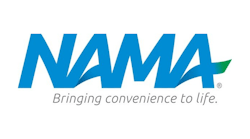Q&A With Carla Balakgie, NAMA President And CEO, About NAMA's New Public Health Commitment
Q: What is the industry’s Public Health Commitment?
A: It’s a public statement, a public acknowledgement and a public recognition that our industry chooses to be part of a solution around public health. We have a track record of this, and this is the next iteration of that. We are voluntarily "doing well by doing good." We voluntarily seek to increase the availability of products that meet publicly-recognized health standards in vending.
If you think about the reasons for that, people love to vilify vending. Vending is a longstanding institutional retail channel, but it's also using really cool and innovative unattended retail solutions for the future. We touch millions of consumers every day, and it’s our responsibility to give them both what they want and what the societal trends are demanding.
Q: Why is this being done?
A: We feel we have a responsibility to serve consumers in ways that are good for them, which means making it convenient, fresh, available, seamless and frictionless. And making sure they have good retail options that support a healthy lifestyle. Nobody's arguing that our society, in general, couldn’t benefit from improved health. But why else, situationally, to this channel? Well, timing is everything, so in the opportunity realm, consumers want it, so we’re responding to consumer demand. There was a time when maybe that wasn’t the case, but now there's an opportunity to do well by doing good to provide good things, and to be a part of a solution and give the people what they want.
So, there's market demand — let's call that tailwind. And the other half of that coin could be considered headwind, and that is the increasing pressure and scrutiny that comes from the government and from private sector and public health organizations. They can enforce the changes that they want. If we did nothing, perhaps it wouldn’t change our merchandising or our footprint today, but someone would seek to change it for us. And that would be through regulation, legislation or just vilifying the channel. This is common. It's like the carrot and the stick: the carrot is the market opportunity and the stick is the increasing amount of public policy and public relations, media scrutiny or pressure from groups who would be happy if we sold 100% "better for you." It’s not one simple thing – consumers want it, there’s market opportunity, there’s increasing pressure of governments and advocacy groups, and it’s the right thing to do. And it’s doable. As an association, this is really our job to help the industry step forward, and it's completely voluntary.
Q: Where does the Commitment stand, and when will this Commitment be finalized?
A: Our goal is by the end of 2019. We’ve been working on this for a year. What takes so long? The timing is reflective of the seriousness with which we're going about this. Our guiding principles are that this effort be meaningful, that it be measurable and that it be business tenable. Meaningful and measurable is for us, but it’s really also for our critics and those who are watching. And the business tenable is making sure that we're pushing ourselves as far as we possibly can while not going out of business in the process.
We've spent a lot of time really trying to understand how this will impact our business, looking at the real market demand, and modeling different approaches to how we increase availability and still make sure that the economics work for every part — for the manufacturing companies, for the operators, for all the people in the supply chain as well as the consumer. And it’s voluntary, so people are doing it out of the goodness of their hearts, and they're also having to carve out time from their daily operations to do this additional work. We’re in the final stage of testing now, which means we should be able to get this done by the end of the year.
Q: Why announce anything before this Commitment is final?
A: We are in Washington, D.C., the center of the federal government, and we have between 250 and 300 of our member voices collected in one place. And they’re talking to their elected officials about issues that affect our industry. Honestly, there’s nothing more powerful than a member talking to a public official, especially when they're in their voting district. So, we have this prime opportunity to have the entire cross-section of the industry here, and we want to demonstrate to public officials what we are doing, even though we haven’t finalized the actual specifics. We want to let them know that we’re competent enough, that we’re doing this and we're willing to tell them now, while we're all together. And to get as much exposure as we can and then say, ‘Just stay tuned, because we'll get back to you with the details.’ And honestly, it puts us on the hook, too — it's kind of hard to go backwards once you make a statement.
Q: Are there partner organizations working on this?
A: Even though we don’t know if everything will make the cut — in selecting products and increasing availability of products — we're obviously looking for things that already have a track record of selling. And we're looking for things that meet as many of the public health standards that exist as possible.
We’re looking to reach as many of those standards as possible and have a commitment that is expansive enough that it’s meaningful. Sometimes when you go a mile wide and you try to hit every standard, you only have 10 products. And believe me, we have a lot more than 10 — we have hundreds and hundreds that meet the standards, which is a pleasant surprise, by the way.
We hope to have as many groups standing with us possibly to include the American Heart Association; Partnership for a Healthier America; Alliance for Healthier Generation and CSPI (Center for Science in the Public Interest). We’ve been having ongoing conversations with them throughout this process of developing the commitment. More than one have said that they’re really impressed. Which is not passing judgement on other commitments, but it’s been praiseworthy from their perspective.
So, I’m hopeful that this is a sign that if we’re taking it that seriously, they will, too. It will make our commitment unique if we have more than one partner, and that's our hope — that we would have as much of the public health community going, "Attaboy" with us when we stand up and make that commitment.
Q: What’s next?
A: This is the first public announcement about the commitment. I talked about it during my speech at the NAMA Show, but that was industry specific. I didn’t get to this level of specificity, but that term "doing well by doing good" was the theme of it.

Abby White
Abby White is a former chief editor for Automatic Merchandiser and VendingMarketWatch.com.






